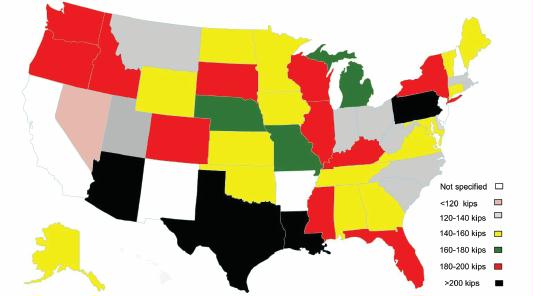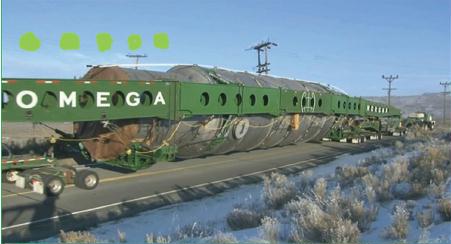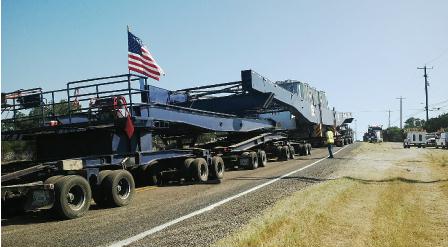
Preface. I’m writing a book now which concludes that only biomass and biofuels can replace diesel and other fossil fuels. But 3 billion people are expected to arrive by 2050, consuming a good chunk of the biomass, plus it will be needed to replace half a million products made from fossil fuels, generate heat for homes and buildings, generate electricity, and dozens of other fossil fuel uses. Rural roads will take even more of a beating than they already are.
There are two articles below, the first about rural roads falling apart, and the second excerpts from a 302 page National Research Council study of Super Heavy commercial trucks that can weigh 2 million pounds. Ouch. Though after reading the whole damn thing, I never did found out the cost we taxpayers shoulder. But I did find what these super heavy objects were of interest, and show some of them below.
Alice Friedemann www.energyskeptic.com author of “When Trucks Stop Running: Energy and the Future of Transportation”, 2015, Springer, Barriers to Making Algal Biofuels, and “Crunch! Whole Grain Artisan Chips and Crackers”. Podcasts: Collapse Chronicles, Derrick Jensen, Practical Prepping, KunstlerCast 253, KunstlerCast278, Peak Prosperity , XX2 report
***
Cohen, P. 2020. The struggle to mend America’s rural roads. As supersize vehicles bear heavier loads, maintenance budgets can’t keep up. New York Times.
Picture this: County highway workers in bright safety vests pour scalding liquid rubber bandages on the road to cover the worst gashes. From above, it looks like skywriting — as if the bandages on the highway were spelling out a message for readers in the clouds.
The roads look like losers in a barroom brawl. Thick, jagged cracks run down the asphalt like scars, interrupted at points by bruised bumps. In some places, guardrails are tilted off their moorings like a pair of glasses knocked askew.
Rural roads are falling apart in small agricultural counties and towns across the Midwest and South, with eroding shoulders dangerous to the 80,000 pound trucks full of soybeans careening down the road. Reconstruction costs $300,000 per mile, and short-term patching $17,000 per mile.
Two-thirds of U.S. freight originates in rural areas where traffic volume has increased from heavy supersized tractor-trailers and farm equipment. In the spring thaw, melting will create soft spots easily damaged by heavy trucks.
These behemoths can produce 5,000 to 10,000 times the road damage of one car (TIC 2020). Although only 19% of American’s live in rural areas, they have 68% of total road miles.
Asphalt roads only have a lifespan of 30 years. Some county’s have roads far older than that.
The result is emergency closings and weight limits. Sometimes a farmer can’t easily move equipment from one field to another. Truckers have to make long detours to deliver feed and fertilizers. Trucks break down with broken axles, wrecked suspension systems, and flat tires.
States often don’t have the money to fix roads. For example, in Wisconsin the gas tax hasn’t gone up since 2006. Often there’s no state or federal assistance either.
Reference
TIC. 2020. How vehicle loads affect pavement performance. Transportation Information Center, University of Wisconsin, Madison.
***
NRC. 2015. Practices for Permitting Superheavy Load Movements on Highway Pavements. National Research Council, National Academies Press.
This report documents the practices followed in issuing permits for overweight and superheavy commercial vehicles (SHCVs) or “superloads.” These are trucks that exceed the thresholds set for overweight vehicles allowed to operate with annual permits throughout state highway networks. This synthesis collected detail on the practices that U.S. states and Canadian provinces use. It focuses on SHCV issues related to pavements.
The GVW of the heaviest SHCV ever permitted by some agencies exceeds 2 million pounds

570,000 pound vehicle carrying an electrical anode used in the copper refining process. It was subjected to a bridge analysis, but not to a pavement analysis. It traveled from Nevada to Miami through Arizona
A massive 900,000 pound water purification vessel used in oil refining was transported from its manufacturing origin in Portland through Oregon, Idaho, and Montana to its final destination in Alberta, Canada. The fee levied was just $4.26/mile for the entire vehicle. No seasonal restrictions were placed on the movement of this load because it was determined that the subgrade soil conditions encountered were relatively dry and therefore not susceptible to frost heave and/or spring thaw. The move took place in November 2013, during which frost and non-frost conditions were encountered. The vessel was delivered by Columbia River barge to Umatilla, Oregon, traveled for a short distance east on I-84, and then followed secondary roads south to the Idaho border near Ontario, Oregon. The vehicle had an overall length of 375 ft, 4 in. and a width of 22 ft, 2 in. Its GVW was 900 kips and its maximum tandem axle load was 44.75 kips. It was equipped with 32 axles and its maximum tire unit load was 604 lb/in. It was propelled by two pusher tractors and one pull tractor. No pavement analysis was conducted for its impact on the I-84 continuous reinforced concrete pavement.
This 1.2 million pound truck is hauling a transformer from East Houston to Flat Rock, Texas, in August 2014. It had a total of 31 axle assemblies and measured 320 ft, 4 in. in length and 20 ft, 3 in. in width. The picture was taken on FM Road 3009 in Bexar County, Texas. Each trailer axle assembly consisted of two 4-tire axles side-by-side, taking the width of two adjacent roadway lanes. The heaviest axle assembly of this vehicle was 48,000 lb divided among eight tires. The move involved flag vehicles and police escorts. The permit fee charged for this vehicle was $935 and stipulated that the hauler is liable of any infrastructure damage.
The practices of permitting superheavy commercial vehicles (SHCVs) in the United States varies widely between agencies in terms of both the criteria used to define them, the analysis details for evaluating their impact on pavements, and the fees levied for permitting them.
The gross vehicle weight (GVW) thresholds used to define SHCVs vary from 120 kips to 254.3 kips. Axle load limits by configuration also vary, ranging from 20 to 29 kips for single axles on dual tires, from 34 to 60 kips for tandem axles on 8 tires, and from 50 to 81 kips for tridem axles on 12 tires. In addition, some agencies set limits on the tire weight per unit width (i.e., it varies between 500 and 800 lb/in.), whereas others do not. This obvious lack of uniformity in weight regulations reduces the weights of SHCVs traveling through multiple jurisdictions to the least common set of rules in effect through the jurisdictions involved and imposes a considerable administrative burden on shipping companies.
The literature review also suggests that SHCV single-trip fees vary considerably among the 62 jurisdictions in North America (i.e., 50 states, the District of Columbia, ten Canadian provinces, and the Yukon Territory): • Twenty-three (37%) levy SHCV permit fees that are a function of weight-distance, typically in the form of $/ton/ mile for GVW exceeding a certain value. Interestingly, some of the states that use weight-distance taxes do not use the same approach for levying SHCV permit fees. This fee ranges from $0.006/ton/mi to $0.2/ton/mi with an average value of about $0.049/ton/mi. • Fifteen (24%) levy SHCV permit fees that are related to GVW per axle weight alone and do not consider the distance traveled by the vehicles. • Eight (13%) levy a flat SHCV permit fee that ranges from $5 to $550, regardless of any pavement usage indicators, that is the weight of the vehicle or the distance traveled. • Seven (11%) levy a processing fee and may add an infrastructure usage fee after studying SHCVs on a case-bycase basis. • Two jurisdictions (3%) levy a flat fee and the cost of repairing the infrastructure from any damage rather than the cost infrastructure utilization from SHCV movement.
Thirty-eight agencies responded as to whether or not they conduct pavement analysis as part of their SHCV permit process. Of those, five (13%) always do (Delaware, Missouri, Louisiana, Tennessee, and Vermont), 15 (40%) do so depending on the circumstances (Arizona, Colorado, Iowa, Illinois, Indiana, North Carolina, North Dakota, Oregon, Washington State, Wisconsin, Wyoming, Texas, Virginia, British Columbia, and Ontario), whereas the remaining 18 agencies (47%) never perform such an analysis. The majority of the agencies that perform pavement analysis do so when dealing with a vehicle exceeding their definition of a SHCV. Details of pavement analysis performed were provided by 15 states. Their majority uses either their own in-house developed mechanistic empirical pavement analysis approach or the mechanistic methods developed by industry (i.e., Asphalt Pavement Association and Portland Cement Association). Several agencies indicated that they use the 1993 AASHTO Guide for the Design of Pavement Structures and characterize the truck loads in terms of equivalent single axle loads. None of the responding agencies uses the Mechanistic-Empirical Pavement Design Guide for analyzing the impact of SHCV. Additional details on the pavement analysis performed by the 15 responding states suggest that their majority uses representative thickness and layer/subgrade moduli, and consider the entire length of the SHCV. About half consider only one wheel path and the actual number of tires in the wheel path and the tire inflation pressure, while approximately 25% consider the actual vehicle speed. Furthermore, only four of the 15 responding agencies consider the stability of the pavement subgrade and of those one indicated using a Mohr– Coulomb type of analysis and another using a slope-stability numerical method type of analysis. The number of SHCV permits issued annually varies between agencies and to a large extent depends on their definition of SHCVs. The range is from fewer than 100 to more than 10,000 per year.
There have been regional efforts to establish uniform heavy truck permitting regulations in the United States, whereby a permit issued by one state is accepted for travel in other states. Twelve western states, under the auspices of the Western Association of State Highway and Transportation Officials (WASHTO), Arizona, Colorado, Idaho, Louisiana, Montana, New Mexico, Nevada, Oklahoma, Oregon, Texas, Utah, and Washington, agreed on a uniform set of truck weight regulations that allow trucks permitted in one of these states to legally operate throughout the rest. In summary, these limits consist of a GVW of 160 kips; tire weights of 600 lb/in. of width; overall consecutive axle weight limits governed by the Bridge Formula; and axle configuration weight limits of 21.5, 43, and 53 kips for single, tandem, and tridem axles, respectively.
The literature review suggests that SHCV single-trip fees vary widely between the 62 jurisdictions in North America (i.e., 50 states, the District of Columbia, ten Canadian provinces, and the Yukon Territory): • Twenty-three (37%) levy SHCV permit fees that are a function of weight-distance, typically in the form of $/ton/mile for GVW exceeding a certain value. Interestingly, some of the states that use weight-distance taxes do not use the same approach for levying SHCV permit fees. This fee ranges from $0.006/ton/mi to $0.2/ton/mi, with an average value of about 0.049/ton/mi. • Fifteen (24%) levy SHCV permit fees that are related to GVW/axle weight alone and do not consider at all the distance traveled by the vehicles. • Eight (13%) levy a flat SHCV permit fee that ranges from $5 to $550 regardless of any pavement usage indicators; that is, the weight of the vehicle or the distance traveled. • Seven (11%) levy a processing fee and may add an infrastructure usage fee after studying SHCVs on a case-by-case basis.
Two jurisdictions (3%) levy a flat fee and the cost of repairing the infrastructure from any damage rather than the cost infrastructure utilization from SHCV movement.
The definition of a SHCV or “superload” varies significantly among jurisdictions. Sixteen of the responding agencies (41%) define SHCV in terms of GVW alone, five (13%) use GVW and axle loads regardless of axle spacing, and another five (13%) use GVW and axle loads as a function of axle spacing. Interestingly, the remaining 13 responding agencies (33%) use an alternative definition involving vehicle size, tire loading, axle spacing, and roadway condition.
Thirty-eight agencies responded as to whether or not they conduct pavement analysis as part of their SHCV permit process. Of those, five (13%) always do (Delaware, Missouri, Louisiana, Tennessee, and Vermont), 15 (40%) do so depending on the circumstances (Arizona, Colorado, Iowa, Illinois, Indiana, North Carolina, North Dakota, Oregon, Washington, Wisconsin, Wyoming, Texas, Virginia, British Columbia, and Ontario), whereas the remaining 18 agencies (47%) never perform such an analysis. The majority of the agencies that perform pavement analysis do so when dealing with a vehicle exceeding their definition of a SHCV. Details on the pavement analysis performed were provided by 15 states. Their majority uses either their own in-house developed mechanistic-empirical pavement analysis approach or the mechanistic methods developed by industry. Several agencies indicated that they use the 1993 AASHTO Guide for the Design of Pavement Structures and characterize the traffic in terms of equivalent single axle loads. None of the responding agencies uses the Mechanistic-Empirical Pavement Design Guide for analyzing the impact of SHCVs.
Additional details on the pavement analysis performed by the 15 responding states suggest that the majority use representative thickness and layer/subgrade moduli and consider the entire length of the SHCV. About half of them consider only one wheel path, the actual number of tires in the wheel path, and the tire inflation pressure, while approximately 25% consider the vehicle speed. Furthermore, only four of the 15 responding agencies consider structural failure of the pavement layers and subgrade as part of the SHCV permitting analysis. Only two of these four states gave details on the actual method used for analyzing the structural stability of the pavement layers.
The results of the survey questionnaire confirmed the findings of the literature review on the various methodologies agencies use for computing SHCV permit fees. Fifteen of the 46 responding agencies (33%) use a GVW-distance-traveled approach (Alabama, Florida, Illinois, Ohio, Missouri, Montana, North Dakota Tennessee, Utah, Vermont, Washington, West Virginia, Wyoming, British Columbia, and Ontario), two use a pavement damage-distancetraveled approach (Arizona and Oregon), another two use a number of axles-distance-traveled approach (Idaho and New Jersey), while 19 (41%) use a different methodology.
The findings of this study suggest that the practice of permitting SHCVs could be significantly improved through further study of their impact on pavements and implementation of the results in establishing equitable permit fees that cover pavement utilization and/or damage.
INTRODUCTION
There is an increasing demand for highway transport of very large non-divisible shipments that not only exceed legal gross vehicle weight (GVW) and axle weight limits, but also exceed the special provisions that allow overweight vehicles to operate with routine annual permits. Such vehicles are typically allowed to operate under single-trip permits following an engineering analysis of their impact on the pavement infrastructure (pavements and bridges) on a specific route.
State and provincial practices on permitting such vehicles, henceforth to be referred to as superheavy commercial vehicles (SHCVs) or “superloads,” have a significant impact on both transportation efficiency and infrastructure condition.
The condition of the pavement infrastructure is affected where the fees collected for SHCV permitting do not cover the pavement damage cost caused by these vehicles.
The differences in weight limits between jurisdictions, even those that have common borders, are substantial. For example, a vehicle with a GVW between 150 and 199 kips crossing the Florida–Georgia border would require a SHCV permit review in Georgia but not in Florida, and would be required to have a unit tire weight of less than 550 lb/in. only in Florida, since Georgia does not have this requirement.
Similarly, a vehicle with a GVW between 144 and 191 kips crossing the Minnesota–Wisconsin border would require a SHCV permit review in Minnesota but not in Wisconsin, and would face different maximum permitted axle weights (e.g., tandem axle weights of 40 versus 60 kips and tridem axle weights of 60 versus 81 kips, respectively).
Clearly, there is a lack of uniformity in weight regulations for SHCVs between jurisdictions.
As mentioned earlier, the U.S. Congress recently authorized a Comprehensive Truck Size and Weight Limits Study (1) under MAP-21 funding (Moving Ahead for Progress in the 21st Century Act; Section 32801), with the following objectives: • Address the differences in safety risks, infrastructure impacts, and the effect on levels of enforcement between trucks operating at or within federal truck size and weight limits and trucks legally operating in excess of federal limits; • Compare and contrast the potential safety and infrastructure impacts of alternative configurations (including configurations that exceed current federal limits) to the current federal truck size and weight law and regulations; and • Estimate the effects of freight diversion resulting from these alternative configurations.
DEFINITION OF SUPERHEAVY COMMERCIAL VEHICLES
This section summarizes the survey results related to background questions and the way SHCVs are defined and permitted in each jurisdiction. 16 of the responding agencies (41%) define SHCV in terms of a maximum GVW alone. They vary widely from 120 to 500 kips, with the most frequent value being 200 kips. Five of the responding agencies (13%) reported that they define SHCV in terms of GVW and axle group limits regardless of axle spacing. The wide range of GVW and load limits is again evident; GVW limits range from 80 kips to 350 kips and tandem axle loads, for example, range from 34 kips to more than 60 kips. Another five of the responding agencies (13%) define SHCV in terms of GVW and axle group limits as a function of axle spacing. The distribution of these GVW limits, the axle group load limits, and the corresponding minimum axle spacings. In this case, GVWs vary from 100 to 254 kips, tandem load limits from 40 to 50 kips, whereas minimum tandem axle spacings vary from 6 to 12 feet.




3 Responses to Super heavy trucks ruin roads